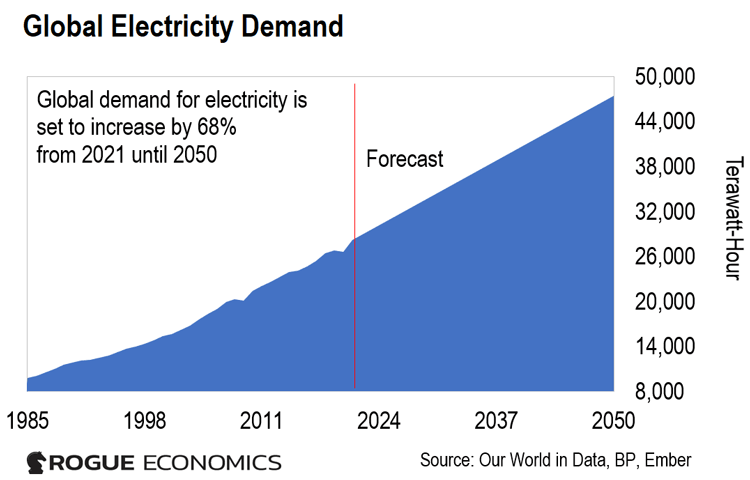Maria’s Note: Today, we hand the reins to Rogue Economics senior analyst John Pangere.
John is Nomi’s co-editor at our Rogue Strategic Trader advisory. And he has done just about everything in the investing world…
He’s got an engineering degree from Purdue University. He managed multimillion-dollar construction projects before switching to finance. And he’s also a former investment banker. As a banker, he worked on late-stage venture deals and with early-stage startups.
And at Strategic Trader, he uses his years of experience to deliver massive gains for subscribers. Gains as high as 2,174%… 2,805%… and even 4,942%.
In the essay below, John homes in on a $14 trillion trend in one of Nomi’s favorite sectors right now – energy…
The lights went out at 9:43 p.m. on a Wednesday night. Everything plunged into darkness.
So I grabbed a couple of battery-powered lanterns. Then I went to the garage to fire up the backup generator.
Trouble was the generator wouldn’t turn over. No problem, I thought. The power goes out often enough, so I know it usually kicks back on within a few hours.
But this was no ordinary power outage. It was an outage in the middle of an ice storm.
After 30 minutes, the weather went from bad to worse. Temperatures plunged from 35 degrees to the low 20s.
Luckily, I grew up in the Midwest. I expect these kinds of things to happen. So, with my backup plan down, I moved on to plan C.
I packed some bags. Rustled the kids from their slumber. Then drove over to grandma and grandpa’s house.
The next day, I surveyed the damage. The ice built up so much overnight, tree branches couldn’t handle the load. Luckily, the mailbox survived…

Tree branches buckle under the weight of the ice
But there was still no power. Power lines were down everywhere.
And not just in my community. By Thursday afternoon, up to 1.75 million people across my home state of Michigan were without power.
When the power came back four days later, the temperature in my house had dropped to 44 degrees. It was an icebox.
But as I said, I was prepared. I know to have backup plans for my backup plans.
The Grid Needs a Massive Upgrade
If my story sounds familiar, it should. In February 2021, Texas suffered something similar.
Severe winter storms with below-freezing temperatures swept across parts of the state. They triggered the worst energy infrastructure crisis in Texas history.
More than 4.5 million homes and businesses lost power after the power grid failed. It also led to shortages of food and water.
For some, the lights were out for weeks. The state’s after-action report estimates that property damage was over $195 billion.
This was a tragedy. The state and its residents were not prepared. Except they could have avoided the entire debacle…
Just 10 years prior, the Electric Reliability Council of Texas knew its power grid could fail in such a storm. That was after the Groundhog Day blizzard of February 2011 rocked the state.
And whether it’s in Texas or my home state, the problems with the power grid may just be getting started.
That’s because we have an insatiable demand for power. We can see that in the chart below…

In just 35 years, global demand for electricity has more than tripled. And that trend isn’t going to slow down anytime soon.
That’s because we’re plugging in more than ever before. According to a recent study by consulting firm Deloitte, the average U.S. household has 25 connected devices. That’s more than double the average from just four years ago.
Add in more electric vehicles (EVs) hitting the road, and we can see where things are heading.
In fact, California is learning this the hard way. Last summer, state power grid officials warned customers of potential blackouts.
The situation was so bad, they suggested customers “set thermostats to 78 degrees or higher, avoid using large appliances and charging electric vehicles.”
This was just days after the state voted to phase out the sale of new gas cars by 2035.
It’s part of the reason why the world needs to spend $14 trillion over the next 30 years to support the evolving power landscape. That’s based on an estimate from Bloomberg New Energy Finance (BNEF).
In other words, we need more reliable power that can handle freak weather events and the surge of new devices that we plug in every day.
Making the Grade
Without reliable power, we wouldn’t have luxuries like central heating or air conditioning.
The problem is we’re only as good as our current and future infrastructure. And right now, our infrastructure doesn’t inspire much confidence.
Here’s how Nomi put it in a recent edition of her Distortion Report advisory…
The American Society of Engineers [ASCE]’ report card comes out every four years. In 2021, it ranked America’s infrastructure at a C-.
That was the first time it exceeded the D range in two decades. But still, were you ever happy about a C- in school?
Their report covered areas from drinking water to bridges to aviation to energy. It also said America needs $6 trillion to get a B.
In short, we’ve got a lot of work to do.
The ASCE also found that all three major components of the electric grid – generation, transmission, and distribution – have a massive investment gap. They estimate that by 2029, that gap will grow to around $197 billion.
That’s probably not the best way to run a power grid that hundreds of millions of people depend on.
What This Means for Your Money Today
There is some good news on the horizon. The recent $1.2 trillion Infrastructure and Investment Jobs Act may help partially fill the gap.
Sure, we can argue there’s plenty of pork in the bill. But with $65 billion for new and upgraded power projects, it’s a decent start. More reliable power means less chance of massive power outages.
And all that spending means it’s creating some great moneymaking opportunities… if you know where to look.
That’s why Nomi set out to get the latest intel from her contacts in Washington.
She’s an expert when it comes to uncovering investment opportunities with massive government support.
And based on a slew of Zoom calls with her top congressional contacts… Nomi found what she calls a “once-in-a-century opportunity” to play this trend.
See, America’s energy infrastructure is getting an upgrade.
A new law titled S.3428 could unleash a $4 trillion torrent of government money into an energy subsector called “SMR.” And only one firm in America has the federal license to produce it.
The best part is, right now it trades for less than $2. But in the long run, it could deliver as much as 20x gains to early investors.
To learn more, watch Nomi’s Urgent “SMR” Energy Briefing right here.
Regards,

John Pangere
Senior Analyst, Rogue Economics